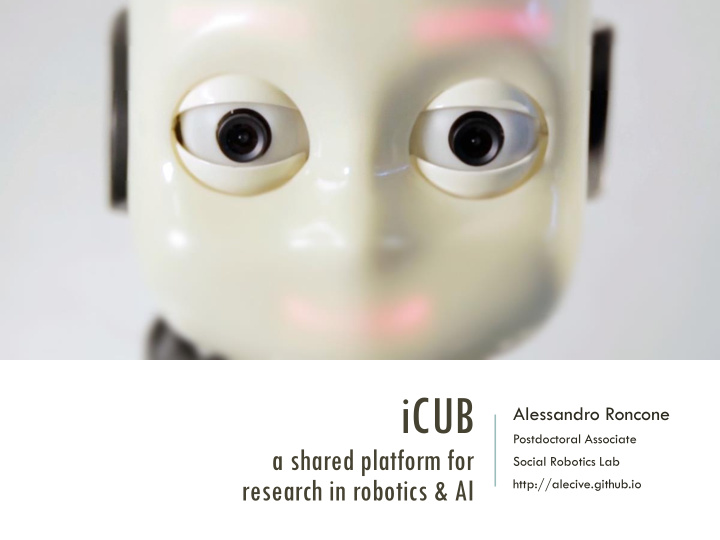



iCUB Alessandro Roncone Postdoctoral Associate a shared platform for Social Robotics Lab research in robotics & AI http://alecive.github.io
IIT - Italian Institute of Technology Italy Genoa IIT Robotics @ IIT
IIT - iCub Facility
The iCub 1. price: 250K€ 2. born in 2004 3. 30 iCub distributed since 2008
Why is the iCub so special? ■ Full humanoid robot (104cm, 25 kg) ■ 53 degrees of freedom (DoFs) ■ Hands: 5 fingers, 9 degrees of freedom, 19 joints ■ Human-like sensors: cameras, microphones, joint encoders, IMUs (accelerometer/gyroscope), force/torque sensors ■ Artificial skin ■ Large software repository (~2M lines of code) ■ Open source HW & SW
Why humanoids? ■ Scientific reasons (elephants don’t play chess) ■ Natural human-robot interaction ■ Challenging mechatronics
Why open source? ■ Repeatable experiments ■ Benchmarking ■ Quality of the HW & SW ■ This resonates with industry-grade R&D in robotics
Why open source?
Outline Hardware Software Force/Torque Sensor YARP Artificial Skin Kinematics/Dynamics Inertial Sensor Computer Vision & Machine Learning
HW1 - Force / Torque sensors ■ placed on the proximal part of the limb ■ able to sense force up to the end-effector ■ critical for many applications: safety, dynamics/control, HRI, ...
HW1 -Force / Torque sensors - Teaching Actions
HW2 - Artificial Skin ■ ground plane: conductive fabric capacitor ■ soft material: e.g. silicone ■ electrodes: flexible PCB
HW2 - Artificial Skin
HW2 - Artificial Skin upper body: 1868 total: 4488 taxels!! legs and feet: 1310x2
HW2 - Artificial Skin for grasping Without tactile feedback With tactile feedback
HW2 - Artificial Skin - Self Calibration
HW3 - Inertial Sensor
HW3 - Inertial Sensor - Gaze Stabilization
Outline Hardware Software Force/Torque Sensor YARP Artificial Skin Kinematics & Dynamics Inertial Sensor Computer Vision & Machine Learning
SW1 - YARP YARP → Yet Another Robot Platform ■ Peer-to-peer, loosely coupled, communication ■ Very stable code base ~15 years old (older than ROS) ■ Flexibility and minimal dependencies, fits well with other systems ■ Easy install with binaries on many OSes/distributions (Ubuntu, Debian, Windows, MacOs) ■ Many protocols: ■ Built-in: tcp/udp/mcast ■ Plug-ins: ROS tcp, xml rpc, mjpeg etc..
SW1 - YARP without hardware ■ Using YARP without hardware: dataset player ■ Available in binary releases for Linux and Windows
SW1 - YARP without hardware ■ Using YARP without hardware: simulators ■ iCub_SIM, and ODE-based simulator ■ Gazebo, the VRC/DRC simulator
SW2 - Inverse Kinematics and Cartesian Control ■ Inverse Kinematics Solver + Controller ■ IK Solver → Non linear constrained optimization ■ Controller → Able to generate smooth, human-like velocity profiles at the end-effector given the desired joint configuration
SW2 - Inverse Kinematics - IPOPT ■ Quick convergence (<10ms) ■ Scalability ■ Singularities and joints bound handling ■ Complex constraints:
SW2 - Inverse Kinematics and Gaze Control ■ The iCub's head has 6DoF ■ The fixation point can be seen as the end-effector of a virtual kinematic chain that starts from the neck base ■ Similar techniques apply
SW2 - Coordinated Cartesian and Gaze Control ■ The red ball is detected thanks to a particle filter tracker ■ The tracker provides the 3D position of the ball w.r.t. the robot ■ The Cartesian controller steers the arm toward the target 3D point ■ The Gaze controller moves the robot’s gaze in the same direction ■ The Force/Torque sensors make the robot compliant
SW2 - Dynamics
SW2 - Dynamics is (theoretically) solvable..
..but hard to implement!
SW3 - Computer Vision & Machine Learning Could you please help Please put me with the TV those into the set? dishwashing machine
SW3 - Computer Vision & Machine Learning The iCub puts the plates into the dishwashing machine actions objects tools
SW3 - Computer Vision & Machine Learning Actions Objects Tools Learn learning objects learning tools learning actions Use recognizing actions recognizing objects using tools
SW3 - Computer Vision for Robotics Teleoperation Markers Structured Environment 3D reconstruction & strong supervision
SW3 - Breakthrough in Computer Vision Deep Learning + Big Datasets = Approaching human performance on the same dataset!
There are better ways to do that! Human-Robot Interaction Self-Supervision kinematics HRI is a natural application for visual recognition In robotics strong cues are often available, therefore object detectors can be avoided motion Recognition as tool for complex tasks: grasp, manipulation, affordances, pose
Semi-autonomous Learning
iCub World 2.0 Dataset ■ Growing dataset collecting images from a real robotic setting ■ Tool for benchmarking visual recognition systems in robotics ■ 28 Objects, 7 categories, 4 different acquisition sessions → ~50K Images ■ http://www.iit.it/en/projects/data-sets.html
iCub World 2.0 Dataset day1 day2 day3 day4 TRAIN TEST ■ Growing dataset collecting images from a real robotic setting ■ Tool for benchmarking visual recognition systems in robotics ■ 28 Objects, 7 categories, 4 different acquisition sessions → ~50K Images ■ http://www.iit.it/en/projects/data-sets.html
Interactive Objects Learning
Thank you! And thanks to: Giorgio Metta Lorenzo Natale, Francesco Nori Ugo Pattacini, Vadim Tikhanoff, Marco Randazzo, Carlo Ciliberto, Daniele Pucci, Francesco Romano, Giulia Pasquale, Sean Ryan Fanello, Ali Paikan, Jorhabib Eljaik, Silvio Traversaro The iCub Facility
Recommend
More recommend